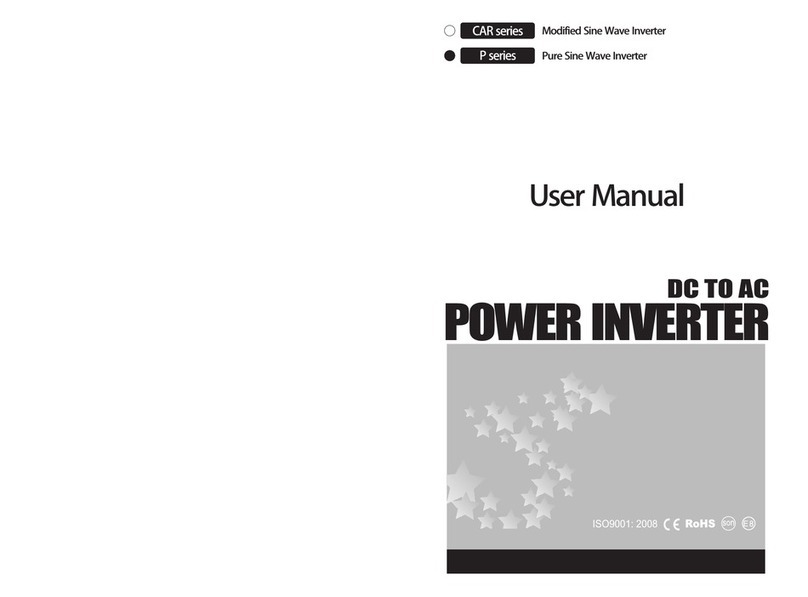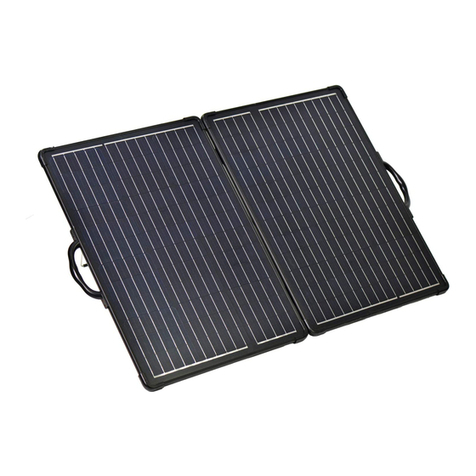Photonic Universe Ltd - Bringing you the benefits of solar power -
Registered office: Tel: +44 (0) 203 150 11 11
13 David Mews Fax: +44 (0) 203 150 12 12
Porter Street Email: info@photonicuniverse.com
London W1U 6EQ UK Web shop: www.photonicuniverse.com
8. Feed the solar panel cables through the cable entry gland, the hole in your roof and then bond the
gland to the roof. Tighten the cable gland nuts after the adhesive has dried.
Adding fuses to your system
Although the solar charge controller has battery protection functions, you can install fuses in each of the
battery circuits for additional protection against short circuits and wiring mistakes. They should be inline
fuses between the solar charge controller and each of the batteries. The size of fuses depends on the
maximum charging current of the solar panel. Please check solar panel specifications for Maximum power
current and choose a fuse with the next available rating higher than that (to a maximum of 10A).
Negative common ground of vehicles and boats
Most vehicles (including campervans and motorhomes) and boats typically have the common ground
when a vehicle body or boat hull is used as a shared connection point by the engine, generator, battery,
lights and other system components. When installing the solar kit on such vehicles / boats, please note
the following:
•To avoid any short circuits or conflicts between you vehicle / boat system and the solar kit system,
you should never ground the solar panel (i.e. never connect it to your vehicle body / boat hull). The
solar panel cables should be fully electrically isolated from your vehicle body / boat hull and should be
connected directly to the solar charge controller.
•Your solar charge controller is a negative common ground device. If you are planning to use the solar
charging kit to charge two separate batteries, the controller can work with these batteries even if their
negative terminals are connected to the same negative common ground of your system. However, in
order to allow the solar charge controller to treat your batteries independently and choose individual
charging programmes, positive terminals of your batteries must be fully electrically isolated from
each other, i.e. they should not be connected to each other or to the same system or wiring. This
electrical isolation of “+” terminals of the batteries from each other will allow the solar charge
controller to use its full dual battery functionality, for example it will be able to split the power from the
solar panel to batteries according to the pre-set priority ratio and it will also be able to stop charging
one of the batteries when full but continue charging the other battery.
Below you can find a description of situations in which you need to use your dual battery solar charge
controller as a single battery controller:
•If the two batteries are connected to different systems with the same negative common ground (e.g.
“engine” and “leisure” battery), but their positive terminals are also connected to a split charger or
switch or another component which might link the batteries together, then the solar charge controller
may not work properly. When the positive terminals of two batteries become linked, the controller will
see both batteries as a mix, and it will not be able to treat batteries independently (e.g. even if you set
the controller to 80%/20% it will still charge them as 50%/50%, and if one of the batteries is full it
might continue charging anyway etc). You should avoid such situations when the positive terminals of
two batteries become linked through another system component such as a split charger or a switch. If
this is required in your system, use the solar charging kit to charge one battery at a time only, keeping
the other pair of battery terminals of the solar charge controller unconnected.
•If your engine and leisure battery are connected to the positive common ground, you cannot use both
Battery 1 and Battery 2 output of the solar charge controller at the same time either. You can only
charge one battery at a time and keep the other pair of battery terminals of the controller
unconnected. Remember: the solar panel cables should not be grounded in any case.
•If you only have one bank of two or more 12V leisure batteries to charge, and these batteries are
connected in parallel (“+” to “+”, and “-“ to “-“), then you should treat them as a single battery and use
only one pair of battery terminals of the solar charge controller to charge them. The other pair of
battery terminals of the controller should remain unconnected.


























